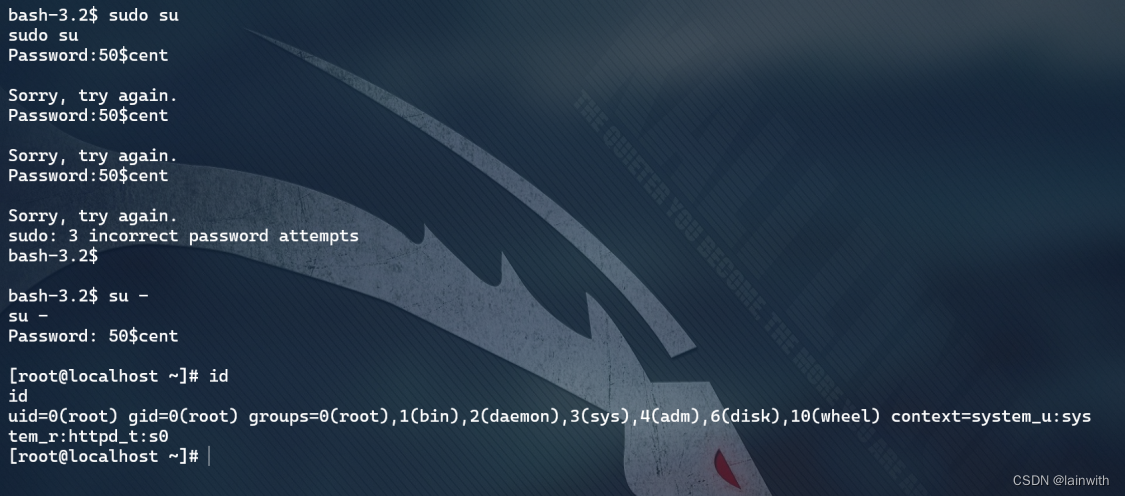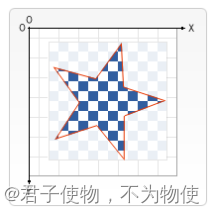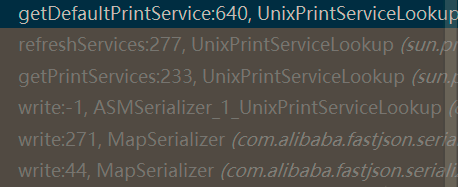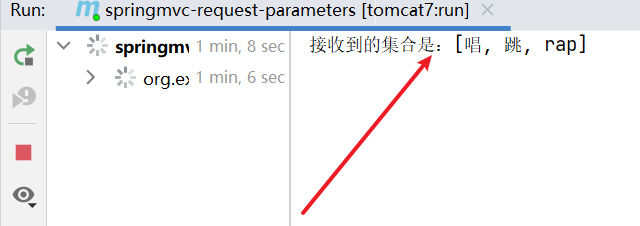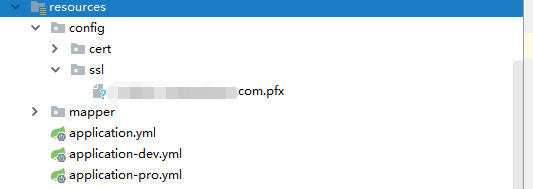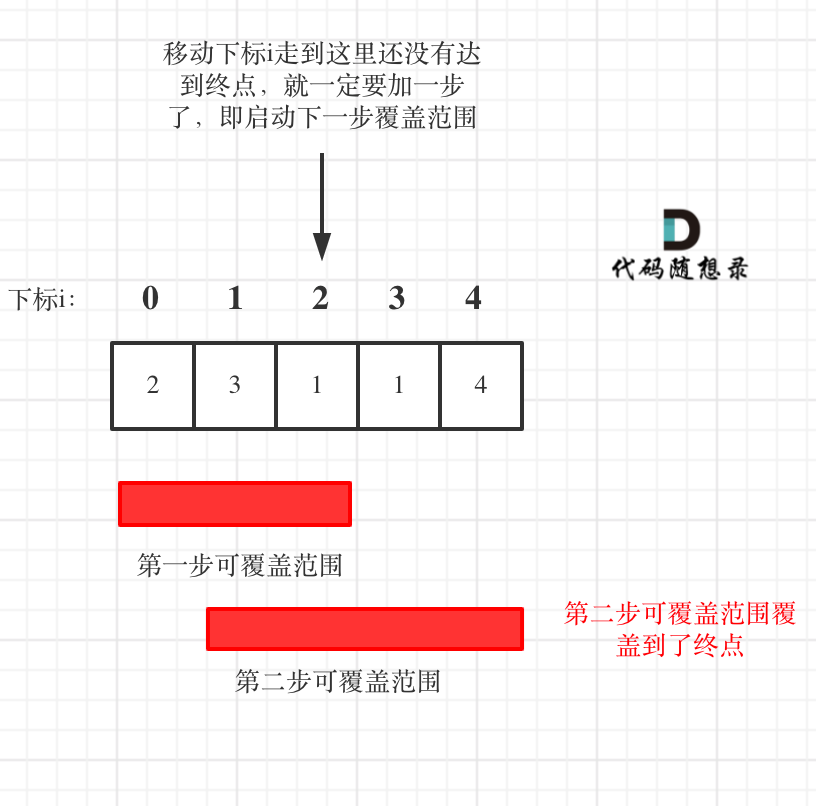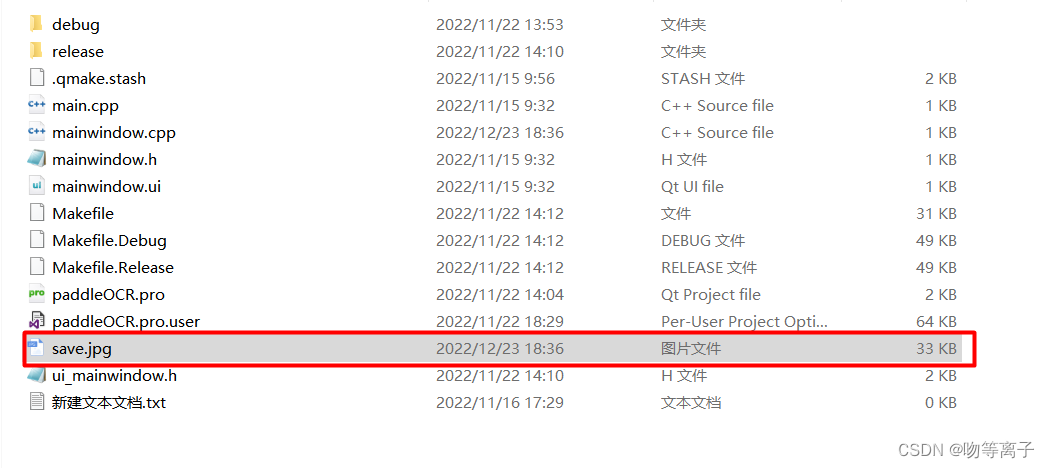SpringSecurity介绍
SpringSecurity是一个用于Java 企业级应用程序的安全框架,主要包含用户认证和用户授权两个方面,相比较Shiro而言,Security功能更加的强大,它可以很容易地扩展以满足更多安全控制方面的需求,但也相对它的学习成本会更高,两种框架各有利弊。实际开发中还是要根据业务和项目的需求来决定使用哪一种.
JWT的认证传输协议
JWT是在Web应用中安全传递信息的规范,从本质上来说是Token的演变,是一种生成加密用户身份信息的Token,特别适用于分布式单点登陆的场景,无需在服务端保存用户的认证信息,而是直接对Token进行校验获取用户信息,使单点登录更为简单灵活。
系统搭建
环境管控
- SpringBoot版本:2.1.6
- SpringSecurity版本: 5.1.5
- MyBatis-Plus版本: 3.1.0
- JDK版本:1.8
Maven依赖如下:
<dependencies>
<dependency>
<groupId>org.springframework.boot</groupId>
<artifactId>spring-boot-starter-web</artifactId>
</dependency>
<dependency>
<groupId>mysql</groupId>
<artifactId>mysql-connector-java</artifactId>
<scope>runtime</scope>
</dependency>
<dependency>
<groupId>org.projectlombok</groupId>
<artifactId>lombok</artifactId>
<optional>true</optional>
</dependency>
<dependency>
<groupId>org.springframework.boot</groupId>
<artifactId>spring-boot-starter-test</artifactId>
<scope>test</scope>
</dependency>
<!--Security依赖 -->
<dependency>
<groupId>org.springframework.boot</groupId>
<artifactId>spring-boot-starter-security</artifactId>
</dependency>
<!-- MybatisPlus 核心库 -->
<dependency>
<groupId>com.baomidou</groupId>
<artifactId>mybatis-plus-boot-starter</artifactId>
<version>3.1.0</version>
</dependency>
<!-- 引入阿里数据库连接池 -->
<dependency>
<groupId>com.alibaba</groupId>
<artifactId>druid</artifactId>
<version>1.1.6</version>
</dependency>
<!-- StringUtilS工具 -->
<dependency>
<groupId>org.apache.commons</groupId>
<artifactId>commons-lang3</artifactId>
<version>3.5</version>
</dependency>
<!-- JSON工具 -->
<dependency>
<groupId>com.alibaba</groupId>
<artifactId>fastjson</artifactId>
<version>1.2.45</version>
</dependency>
<!-- JWT依赖 -->
<dependency>
<groupId>org.springframework.security</groupId>
<artifactId>spring-security-jwt</artifactId>
<version>1.0.9.RELEASE</version>
</dependency>
<dependency>
<groupId>io.jsonwebtoken</groupId>
<artifactId>jjwt</artifactId>
<version>0.9.0</version>
</dependency>
</dependencies>
springboot配置文件
配置如下:
# 配置端口
server:
port: 8888
spring:
# 配置数据源
datasource:
driver-class-name: com.mysql.cj.jdbc.Driver
url: jdbc:mysql://localhost:3306/call_center?serverTimezone=UTC&useUnicode=true&characterEncoding=utf-8&zeroDateTimeBehavior=convertToNull&useSSL=false
username: root
password: root
type: com.alibaba.druid.pool.DruidDataSource
# JWT配置
jwt:
# 密匙KEY
secret: JWTSecret
# HeaderKEY
tokenHeader: Authorization
# Token前缀字符
tokenPrefix: callcenter-
# 过期时间 单位秒 1天后过期=86400 7天后过期=604800
expiration: 86400
# 配置不需要认证的接口
antMatchers: /index,/login/**,/favicon.ico
# Mybatis-plus相关配置
mybatis-plus:
# xml扫描,多个目录用逗号或者分号分隔(告诉 Mapper 所对应的 XML 文件位置)
mapper-locations: classpath:mapper/*.xml
# 以下配置均有默认值,可以不设置
global-config:
db-config:
#主键类型 AUTO:"数据库ID自增" INPUT:"用户输入ID",ID_WORKER:"全局唯一ID (数字类型唯一ID)", UUID:"全局唯一ID UUID";
id-type: AUTO
#字段策略 IGNORED:"忽略判断" NOT_NULL:"非 NULL 判断") NOT_EMPTY:"非空判断"
field-strategy: NOT_EMPTY
#数据库类型
db-type: MYSQL
configuration:
# 是否开启自动驼峰命名规则映射:从数据库列名到Java属性驼峰命名的类似映射
map-underscore-to-camel-case: true
# 返回map时true:当查询数据为空时字段返回为null,false:不加这个查询数据为空时,字段将被隐藏
call-setters-on-nulls: true
# 这个配置会将执行的sql打印出来,在开发或测试的时候可以用
log-impl: org.apache.ibatis.logging.stdout.StdOutImpl
开发核心类
编写JWT工具类
@Slf4j
public class JWTTokenUtil {
/**
* 生成Token
* @Param selfUserEntity 用户安全实体
* @Return Token
*/
public static String createAccessToken(SelfUserEntity selfUserEntity){
// 登陆成功生成JWT
String token = Jwts.builder()
// 放入用户名和用户ID
.setId(selfUserEntity.getUserId()+"")
// 主题
.setSubject(selfUserEntity.getUsername())
// 签发时间
.setIssuedAt(new Date())
// 签发者
.setIssuer("sans")
// 自定义属性 放入用户拥有权限
.claim("authorities", JSON.toJSONString(selfUserEntity.getAuthorities()))
// 失效时间
.setExpiration(new Date(System.currentTimeMillis() + JWTConfig.expiration))
// 签名算法和密钥
.signWith(SignatureAlgorithm.HS512, JWTConfig.secret)
.compact();
return token;
}
}
无权限处理类
@Component
public class UserAuthAccessDeniedHandler implements AccessDeniedHandler{
/**
* 暂无权限返回结果
*/
@Override
public void handle(HttpServletRequest request, HttpServletResponse response, AccessDeniedException exception){
ResultUtil.responseJson(response,ResultUtil.resultCode(403,"未授权"));
}
}
用户未登录处理类
/**
* 用户未登录处理类
*/
@Component
public class UserAuthenticationEntryPointHandler implements AuthenticationEntryPoint{
@Override
public void commence(HttpServletRequest request, HttpServletResponse response, AuthenticationException exception){
ResultUtil.responseJson(response,ResultUtil.resultCode(401,"未登录"));
}
}
登录失败处理类
@Slf4j
@Component
public class UserLoginFailureHandler implements AuthenticationFailureHandler {
/**
* 登录失败返回结果
* @Author Sans
* @CreateTime 2019/10/3 9:12
*/
@Override
public void onAuthenticationFailure(HttpServletRequest request, HttpServletResponse response, AuthenticationException exception){
// 这些对于操作的处理类可以根据不同异常进行不同处理
if (exception instanceof UsernameNotFoundException){
log.info("【登录失败】"+exception.getMessage());
ResultUtil.responseJson(response,ResultUtil.resultCode(500,"用户名不存在"));
}
if (exception instanceof LockedException){
log.info("【登录失败】"+exception.getMessage());
ResultUtil.responseJson(response,ResultUtil.resultCode(500,"用户被冻结"));
}
if (exception instanceof BadCredentialsException){
log.info("【登录失败】"+exception.getMessage());
ResultUtil.responseJson(response,ResultUtil.resultCode(500,"用户名密码不正确"));
}
ResultUtil.responseJson(response,ResultUtil.resultCode(500,"登录失败"));
}
}
登录成功处理类
@Slf4j
@Component
public class UserLoginSuccessHandler implements AuthenticationSuccessHandler {
@Override
public void onAuthenticationSuccess(HttpServletRequest request, HttpServletResponse response, Authentication authentication){
// 组装JWT
SelfUserEntity selfUserEntity = (SelfUserEntity) authentication.getPrincipal();
String token = JWTTokenUtil.createAccessToken(selfUserEntity);
token = JWTConfig.tokenPrefix + token;
// 封装返回参数
Map<String,Object> resultData = new HashMap<>();
resultData.put("code","200");
resultData.put("msg", "登录成功");
resultData.put("token",token);
ResultUtil.responseJson(response,resultData);
}
}
登出成功处理类
@Component
public class UserLogoutSuccessHandler implements LogoutSuccessHandler {
@Override
public void onLogoutSuccess(HttpServletRequest request, HttpServletResponse response, Authentication authentication){
Map<String,Object> resultData = new HashMap<>();
resultData.put("code","200");
resultData.put("msg", "登出成功");
SecurityContextHolder.clearContext();
ResultUtil.responseJson(response,ResultUtil.resultSuccess(resultData));
}
}
编写Security核心类
自定义登录验证
@Component
public class UserAuthenticationProvider implements AuthenticationProvider {
@Autowired
private SelfUserDetailsService selfUserDetailsService;
@Autowired
private SysUserService sysUserService;
@Override
public Authentication authenticate(Authentication authentication) throws AuthenticationException {
// 获取表单输入中返回的用户名
String userName = (String) authentication.getPrincipal();
// 获取表单中输入的密码
String password = (String) authentication.getCredentials();
// 查询用户是否存在
SelfUserEntity userInfo = selfUserDetailsService.loadUserByUsername(userName);
if (userInfo == null) {
throw new UsernameNotFoundException("用户名不存在");
}
// 还要判断密码是否正确,这里我们的密码使用BCryptPasswordEncoder进行加密的
if (!new BCryptPasswordEncoder().matches(password, userInfo.getPassword())) {
throw new BadCredentialsException("密码不正确");
}
// 还可以加一些其他信息的判断,比如用户账号已停用等判断
if (userInfo.getStatus().equals("PROHIBIT")){
throw new LockedException("该用户已被冻结");
}
// 角色集合
Set<GrantedAuthority> authorities = new HashSet<>();
// 查询用户角色
List<SysRoleEntity> sysRoleEntityList = sysUserService.selectSysRoleByUserId(userInfo.getUserId());
for (SysRoleEntity sysRoleEntity: sysRoleEntityList){
authorities.add(new SimpleGrantedAuthority("ROLE_" + sysRoleEntity.getRoleName()));
}
userInfo.setAuthorities(authorities);
// 进行登录
return new UsernamePasswordAuthenticationToken(userInfo, password, authorities);
}
@Override
public boolean supports(Class<?> authentication) {
return true;
}
}
自定义PermissionEvaluator注解验证
自定义权限注解验证
@Component
public class UserPermissionEvaluator implements PermissionEvaluator {
@Autowired
private SysUserService sysUserService;
/**
* hasPermission鉴权方法
* 这里仅仅判断PreAuthorize注解中的权限表达式
* 实际中可以根据业务需求设计数据库通过targetUrl和permission做更复杂鉴权
* @Param authentication 用户身份
* @Param targetUrl 请求路径
* @Param permission 请求路径权限
* @Return boolean 是否通过
*/
@Override
public boolean hasPermission(Authentication authentication, Object targetUrl, Object permission) {
// 获取用户信息
SelfUserEntity selfUserEntity =(SelfUserEntity) authentication.getPrincipal();
// 查询用户权限(这里可以将权限放入缓存中提升效率)
Set<String> permissions = new HashSet<>();
List<SysMenuEntity> sysMenuEntityList = sysUserService.selectSysMenuByUserId(selfUserEntity.getUserId());
for (SysMenuEntity sysMenuEntity:sysMenuEntityList) {
permissions.add(sysMenuEntity.getPermission());
}
// 权限对比
if (permissions.contains(permission.toString())){
return true;
}
return false;
}
@Override
public boolean hasPermission(Authentication authentication, Serializable targetId, String targetType, Object permission) {
return false;
}
}
SpringSecurity核心配置类
/**
* SpringSecurity核心配置类
*/
@Configuration
@EnableWebSecurity
@EnableGlobalMethodSecurity(prePostEnabled = true) //开启权限注解,默认是关闭的
public class SecurityConfig extends WebSecurityConfigurerAdapter {
/**
* 自定义登录成功处理器
*/
@Autowired
private UserLoginSuccessHandler userLoginSuccessHandler;
/**
* 自定义登录失败处理器
*/
@Autowired
private UserLoginFailureHandler userLoginFailureHandler;
/**
* 自定义注销成功处理器
*/
@Autowired
private UserLogoutSuccessHandler userLogoutSuccessHandler;
/**
* 自定义暂无权限处理器
*/
@Autowired
private UserAuthAccessDeniedHandler userAuthAccessDeniedHandler;
/**
* 自定义未登录的处理器
*/
@Autowired
private UserAuthenticationEntryPointHandler userAuthenticationEntryPointHandler;
/**
* 自定义登录逻辑验证器
*/
@Autowired
private UserAuthenticationProvider userAuthenticationProvider;
/**
* 加密方式
* @CreateTime 2019/10/1 14:00
*/
@Bean
public BCryptPasswordEncoder bCryptPasswordEncoder(){
return new BCryptPasswordEncoder();
}
/**
* 注入自定义PermissionEvaluator
*/
@Bean
public DefaultWebSecurityExpressionHandler userSecurityExpressionHandler(){
DefaultWebSecurityExpressionHandler handler = new DefaultWebSecurityExpressionHandler();
handler.setPermissionEvaluator(new UserPermissionEvaluator());
return handler;
}
/**
* 配置登录验证逻辑
*/
@Override
protected void configure(AuthenticationManagerBuilder auth){
//这里可启用我们自己的登陆验证逻辑
auth.authenticationProvider(userAuthenticationProvider);
}
/**
* 配置security的控制逻辑
* @Author Sans
* @CreateTime 2019/10/1 16:56
* @Param http 请求
*/
@Override
protected void configure(HttpSecurity http) throws Exception {
http.authorizeRequests()
//不进行权限验证的请求或资源(从配置文件中读取)
.antMatchers(JWTConfig.antMatchers.split(",")).permitAll()
//其他的需要登陆后才能访问
.anyRequest().authenticated()
.and()
//配置未登录自定义处理类
.httpBasic().authenticationEntryPoint(userAuthenticationEntryPointHandler)
.and()
//配置登录地址
.formLogin()
.loginProcessingUrl("/login/userLogin")
//配置登录成功自定义处理类
.successHandler(userLoginSuccessHandler)
//配置登录失败自定义处理类
.failureHandler(userLoginFailureHandler)
.and()
//配置登出地址
.logout()
.logoutUrl("/login/userLogout")
//配置用户登出自定义处理类
.logoutSuccessHandler(userLogoutSuccessHandler)
.and()
//配置没有权限自定义处理类
.exceptionHandling().accessDeniedHandler(userAuthAccessDeniedHandler)
.and()
// 取消跨站请求伪造防护
.csrf().disable();
// 基于Token不需要session
http.sessionManagement().sessionCreationPolicy(SessionCreationPolicy.STATELESS);
// 禁用缓存
http.headers().cacheControl();
// 添加JWT过滤器
http.addFilter(new JWTAuthenticationTokenFilter(authenticationManager()));
}
}
编写JWT拦截类
编写JWT接口请求校验拦截器
/**
* JWT接口请求校验拦截器
* 请求接口时会进入这里验证Token是否合法和过期
*/
@Slf4j
public class JWTAuthenticationTokenFilter extends BasicAuthenticationFilter {
public JWTAuthenticationTokenFilter(AuthenticationManager authenticationManager) {
super(authenticationManager);
}
@Override
protected void doFilterInternal(HttpServletRequest request, HttpServletResponse response, FilterChain filterChain) throws ServletException, IOException {
// 获得TokenHeader
String tokenHeader = request.getHeader(JWTConfig.tokenHeader);
if (null!=tokenHeader && tokenHeader.startsWith(JWTConfig.tokenPrefix)) {
try {
// 获取请求头中JWT的Token
if (!StringUtils.isEmpty(request.getHeader(JWTConfig.tokenHeader))) {
// 截取JWT前缀
String token = request.getHeader(JWTConfig.tokenHeader).replace(JWTConfig.tokenPrefix, "");
// 解析JWT
Claims claims = Jwts.parser()
.setSigningKey(JWTConfig.secret)
.parseClaimsJws(token)
.getBody();
// 获取用户名
String username = claims.getSubject();
String userId=claims.getId();
if(!StringUtils.isEmpty(username)&&!StringUtils.isEmpty(userId)) {
// 获取角色
List<GrantedAuthority> authorities = new ArrayList<>();
String authority = claims.get("authorities").toString();
if(!StringUtils.isEmpty(authority)){
List<Map<String,String>> authorityMap = JSONObject.parseObject(authority, List.class);
for(Map<String,String> role : authorityMap){
if(!StringUtils.isEmpty(role)) {
authorities.add(new SimpleGrantedAuthority(role.get("authority")));
}
}
}
//组装参数
SelfUserEntity selfUserEntity = new SelfUserEntity();
selfUserEntity.setUsername(claims.getSubject());
selfUserEntity.setUserId(Long.parseLong(claims.getId()));
selfUserEntity.setAuthorities(authorities);
UsernamePasswordAuthenticationToken authentication = new UsernamePasswordAuthenticationToken(selfUserEntity, userId, authorities);
SecurityContextHolder.getContext().setAuthentication(authentication);
}
}
} catch (ExpiredJwtException e){
log.info("Token过期");
} catch (Exception e) {
log.info("Token无效");
}
}
filterChain.doFilter(request, response);
return;
}
}
权限注解和hasPermission权限扩展
Security允许我们在定义URL方法访问所应有的注解权限时使用SpringEL表达式,在定义所需的访问权限时如果对应的表达式返回结果为true,则表示拥有对应的权限,反之则没有权限,会进入到我们配置的UserAuthAccessDeniedHandler(暂无权限处理类)中进行处理.这里举一些例子,代码中注释有对应的描述.
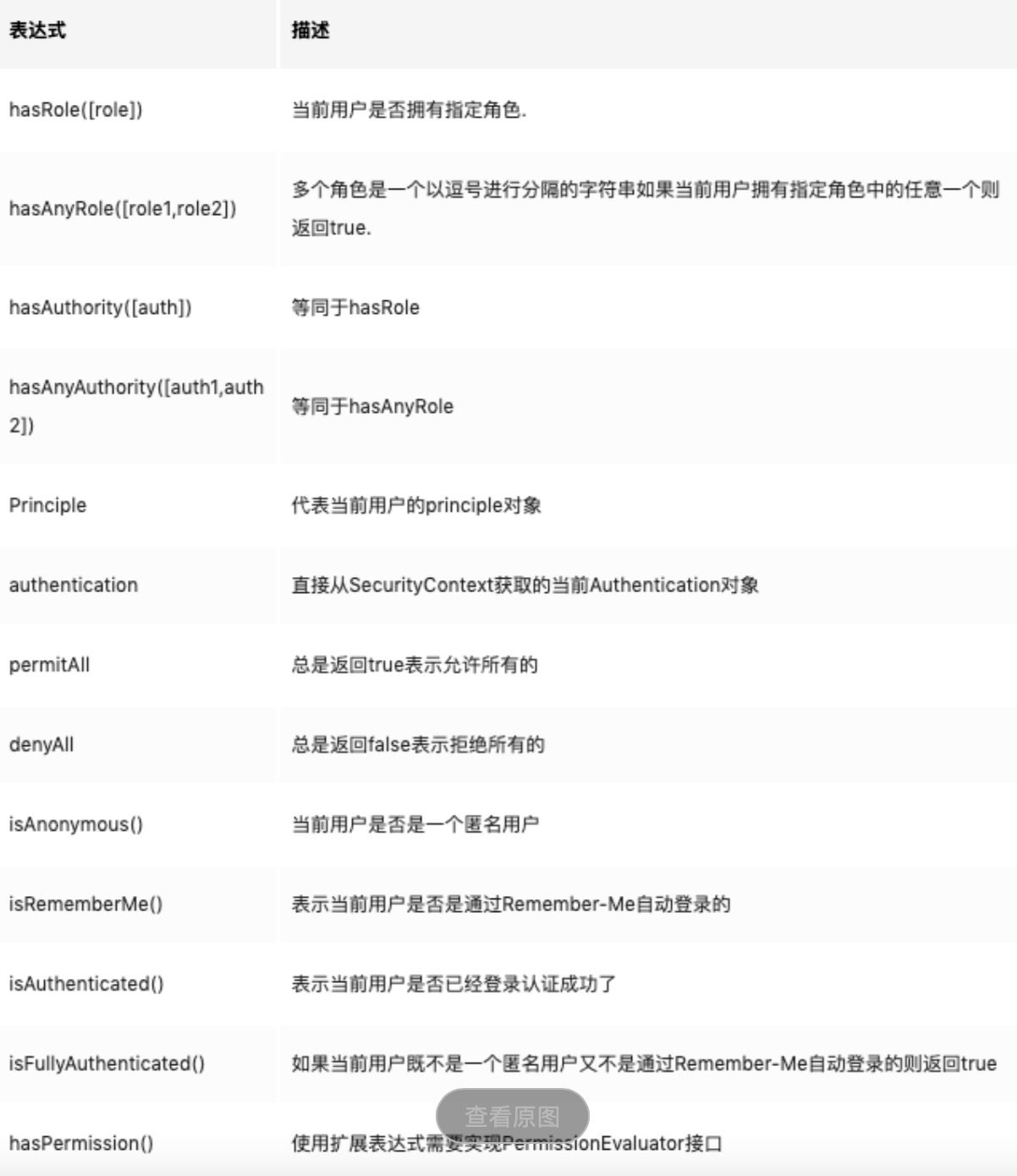
/**
* 管理端信息
* @Return Map<String,Object> 返回数据MAP
*/
@PreAuthorize("hasRole('ADMIN')")
@RequestMapping(value = "/info",method = RequestMethod.GET)
public Map<String,Object> userLogin(){
Map<String,Object> result = new HashMap<>();
SelfUserEntity userDetails = SecurityUtil.getUserInfo();
result.put("title","管理端信息");
result.put("data",userDetails);
return ResultUtil.resultSuccess(result);
}
/**
* 拥有ADMIN或者USER角色可以访问
* @Return Map<String,Object> 返回数据MAP
*/
@PreAuthorize("hasAnyRole('ADMIN','USER')")
@RequestMapping(value = "/list",method = RequestMethod.GET)
public Map<String,Object> list(){
Map<String,Object> result = new HashMap<>();
List<SysUserEntity> sysUserEntityList = sysUserService.list();
result.put("title","拥有用户或者管理员角色都可以查看");
result.put("data",sysUserEntityList);
return ResultUtil.resultSuccess(result);
}
/**
* 拥有ADMIN和USER角色可以访问
* @Return Map<String,Object> 返回数据MAP
*/
@PreAuthorize("hasRole('ADMIN') and hasRole('USER')")
@RequestMapping(value = "/menuList",method = RequestMethod.GET)
public Map<String,Object> menuList(){
Map<String,Object> result = new HashMap<>();
List<SysMenuEntity> sysMenuEntityList = sysMenuService.list();
result.put("title","拥有用户和管理员角色都可以查看");
result.put("data",sysMenuEntityList);
return ResultUtil.resultSuccess(result);
}
通常情况下使用hasRole和hasAnyRole基本可以满足大部分鉴权需求,但是有时候面对更复杂的场景上述常规表示式无法完成权限认证,Security也为我们提供了解决方案。通过hasPermission()来扩展表达式,使用hasPermission(),首先要实现PermissionEvaluator接口
自定义权限注解验证
@Component
public class UserPermissionEvaluator implements PermissionEvaluator {
@Autowired
private SysUserService sysUserService;
/**
* hasPermission鉴权方法
* 这里仅仅判断PreAuthorize注解中的权限表达式
* 实际中可以根据业务需求设计数据库通过targetUrl和permission做更复杂鉴权
* 当然targetUrl不一定是URL可以是数据Id还可以是管理员标识等,这里根据需求自行设计
* @Param authentication 用户身份(在使用hasPermission表达式时Authentication参数默认会自动带上)
* @Param targetUrl 请求路径
* @Param permission 请求路径权限
* @Return boolean 是否通过
*/
@Override
public boolean hasPermission(Authentication authentication, Object targetUrl, Object permission) {
// 获取用户信息
SelfUserEntity selfUserEntity =(SelfUserEntity) authentication.getPrincipal();
// 查询用户权限(这里可以将权限放入缓存中提升效率)
Set<String> permissions = new HashSet<>();
List<SysMenuEntity> sysMenuEntityList = sysUserService.selectSysMenuByUserId(selfUserEntity.getUserId());
for (SysMenuEntity sysMenuEntity:sysMenuEntityList) {
permissions.add(sysMenuEntity.getPermission());
}
// 权限对比
if (permissions.contains(permission.toString())){
return true;
}
return false;
}
@Override
public boolean hasPermission(Authentication authentication, Serializable targetId, String targetType, Object permission) {
return false;
}
}
请求方法上添加hasPermission示例
/**
* 拥有sys:user:info权限可以访问
* hasPermission 第一个参数是请求路径 第二个参数是权限表达式
* @Return Map<String,Object> 返回数据MAP
*/
@PreAuthorize("hasPermission('/admin/userList','sys:user:info')")
@RequestMapping(value = "/userList",method = RequestMethod.GET)
public Map<String,Object> userList(){
Map<String,Object> result = new HashMap<>();
List<SysUserEntity> sysUserEntityList = sysUserService.list();
result.put("title","拥有sys:user:info权限都可以查看");
result.put("data",sysUserEntityList);
return ResultUtil.resultSuccess(result);
}
hasPermission可以也可以和其他表达式联合使用
/**
* 拥有ADMIN角色和sys:role:info权限可以访问
* @Author Sans
* @CreateTime 2019/10/2 14:22
* @Return Map<String,Object> 返回数据MAP
*/
@PreAuthorize("hasRole('ADMIN') and hasPermission('/admin/adminRoleList','sys:role:info')")
@RequestMapping(value = "/adminRoleList",method = RequestMethod.GET)
public Map<String,Object> adminRoleList(){
Map<String,Object> result = new HashMap<>();
List<SysRoleEntity> sysRoleEntityList = sysRoleService.list();
result.put("title","拥有ADMIN角色和sys:role:info权限可以访问");
result.put("data",sysRoleEntityList);
return ResultUtil.resultSuccess(result);
}
测试
创建账户这里用户加密使用了Security推荐的bCryptPasswordEncoder方法
注册用户操作
@Test
public void contextLoads() {
// 注册用户
SysUserEntity sysUserEntity = new SysUserEntity();
sysUserEntity.setUsername("sans");
sysUserEntity.setPassword(bCryptPasswordEncoder.encode("123456"));
// 设置用户状态
sysUserEntity.setStatus("NORMAL");
sysUserService.save(sysUserEntity);
// 分配角色 1:ADMIN 2:USER
SysUserRoleEntity sysUserRoleEntity = new SysUserRoleEntity();
sysUserRoleEntity.setRoleId(2L);
sysUserRoleEntity.setUserId(sysUserEntity.getUserId());
sysUserRoleService.save(sysUserRoleEntity);
}
登录USER角色账号,登录成功后我们会获取到身份认证的Token。
登录用户操作
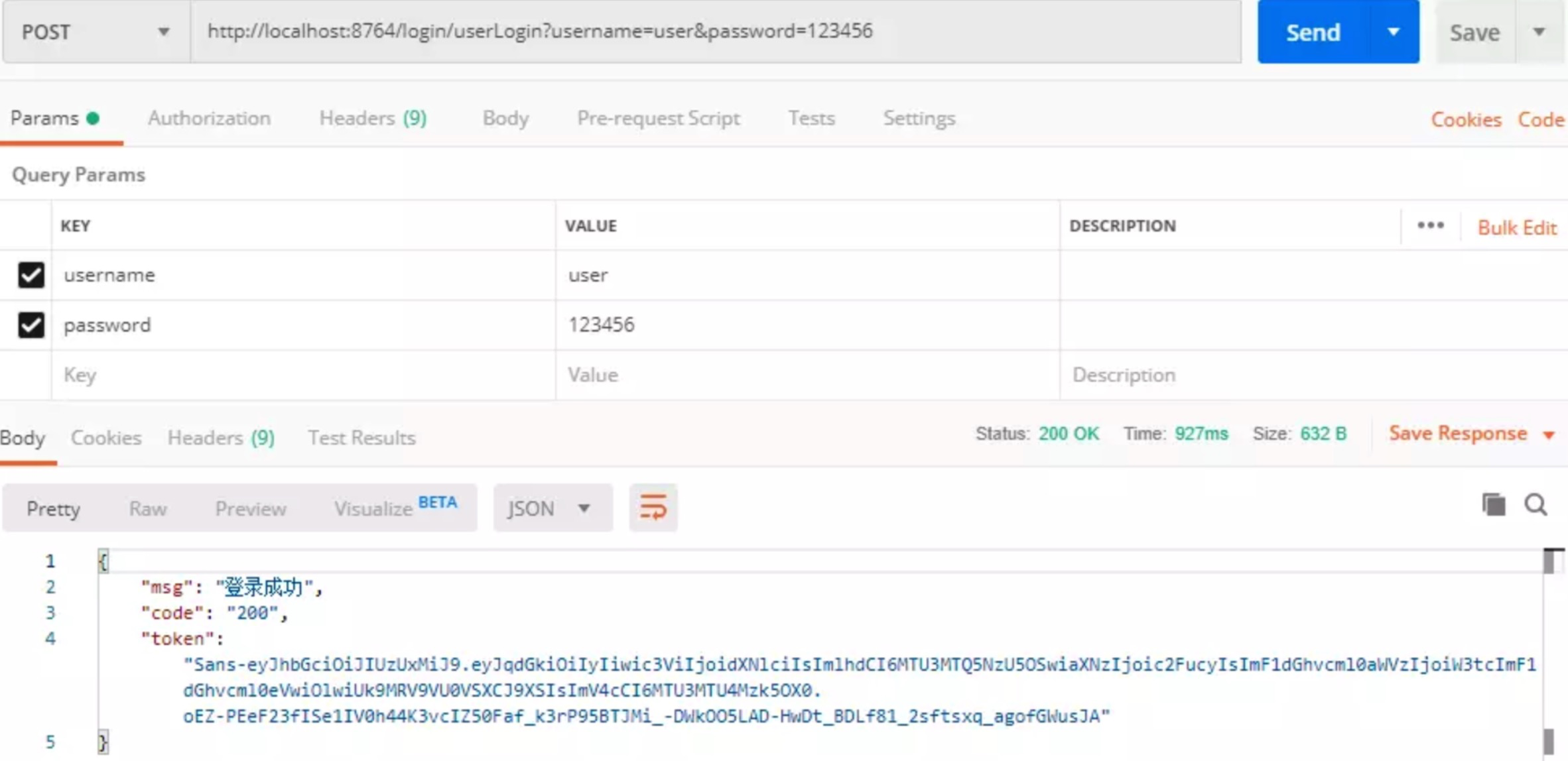
访问USER角色的接口,把上一步获取到的Token设置在Headers中,Key为Authorization,我们之前实现的JWTAuthenticationTokenFilter拦截器会根据请求头中的Authorization获取并解析Token。
查看用户操作
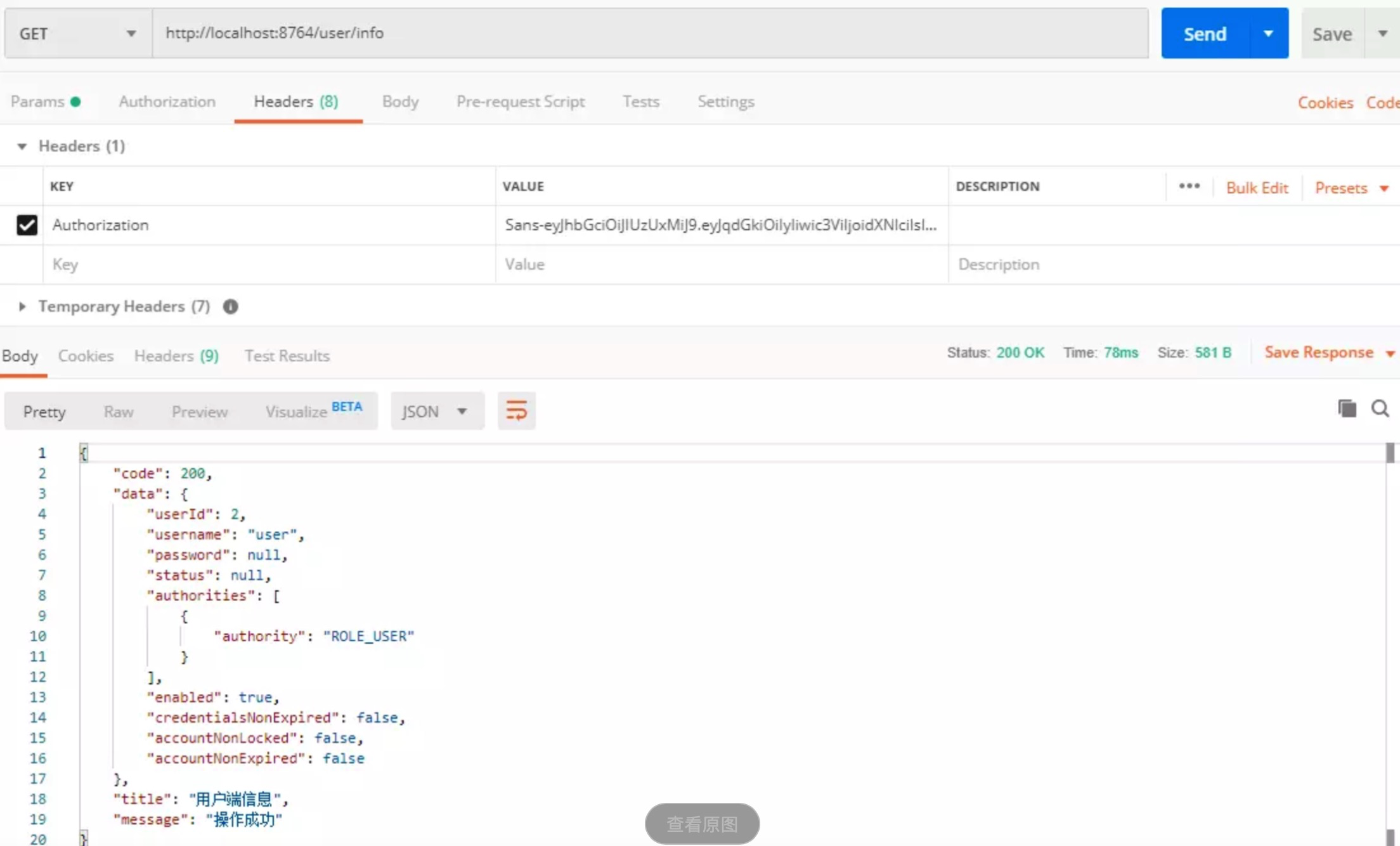

使用USER角色Token访问ADMIN角色的接口,会被拒绝,告知未授权(暂无权限会进入我们定义的UserAuthAccessDeniedHandler这个类进行处理)
更换ADMIN角色进行登录并访问ADMIN接口
查看用户操作
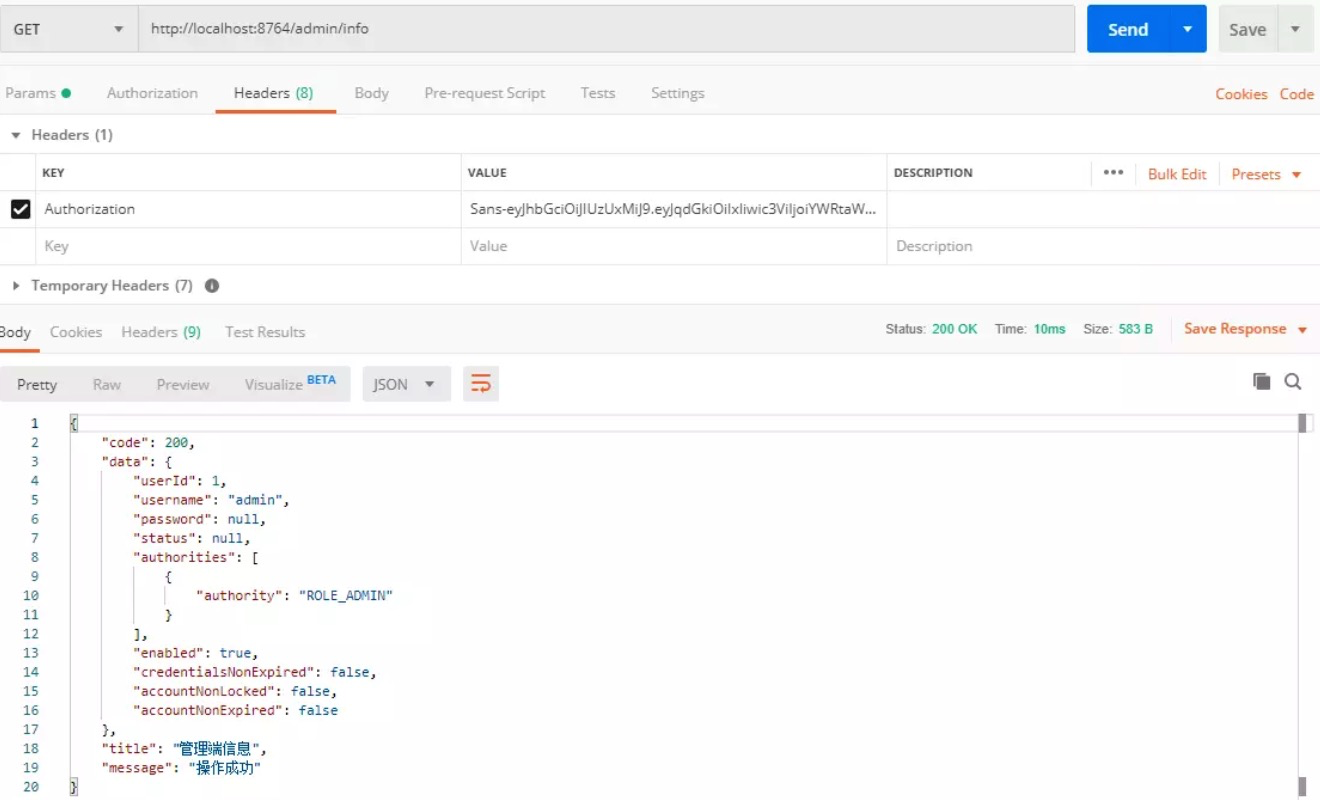
非主线篇
本文讲述一下如何自定义Spring Security的登录认证操作,目前大多数的项目都是基于前后端分离的,但是也有很多场景下也会存在后端模板技术,如何给出一个采用ajax的登录及返回的前后端分离方式并且兼容后端模板技术的功能代码。
AjaxAuthSuccessHandler
public class AjaxAuthSuccessHandler extends SimpleUrlAuthenticationSuccessHandler {
@Override
public void onAuthenticationSuccess(HttpServletRequest request, HttpServletResponse response, Authentication authentication) throws IOException, ServletException {
response.setStatus(HttpServletResponse.SC_OK);
}
}
AjaxAuthFailHandler
public class AjaxAuthFailHandler extends SimpleUrlAuthenticationFailureHandler {
@Override
public void onAuthenticationFailure(HttpServletRequest request, HttpServletResponse response, AuthenticationException exception) throws IOException, ServletException {
response.sendError(HttpServletResponse.SC_UNAUTHORIZED, "Authentication failed");
}
}
ajax的异常处理
public class UnauthorizedEntryPoint implements AuthenticationEntryPoint {
@Override
public void commence(HttpServletRequest request, HttpServletResponse response, AuthenticationException authException) throws IOException, ServletException {
if(isAjaxRequest(request)){
response.sendError(HttpServletResponse.SC_UNAUTHORIZED,authException.getMessage());
}else{
response.sendRedirect("/login.html");
}
}
public static boolean isAjaxRequest(HttpServletRequest request) {
String ajaxFlag = request.getHeader("X-Requested-With");
return ajaxFlag != null && "XMLHttpRequest".equals(ajaxFlag);
}
}
这里我们自定义成功及失败的ajax返回,当然这里我们简单处理,只返回statusCode
security配置
@Configuration
@EnableWebSecurity
public class SecurityConfig extends WebSecurityConfigurerAdapter {
@Override
protected void configure(HttpSecurity http) throws Exception {
http
.exceptionHandling().authenticationEntryPoint(new UnauthorizedEntryPoint())
.and()
.csrf().disable()
.authorizeRequests()
.antMatchers("/login","/css/**", "/js/**","/fonts/**").permitAll()
.anyRequest().authenticated()
.and()
.formLogin()
.loginPage("/login.html")
.loginProcessingUrl("/login")
.usernameParameter("name")
.passwordParameter("password")
.successHandler(new AjaxAuthSuccessHandler())
.failureHandler(new AjaxAuthFailHandler())
.permitAll()
.and()
.logout()
.logoutUrl("/logout")
.permitAll();
}
@Autowired
public void configureGlobal(AuthenticationManagerBuilder auth) throws Exception {
auth
.inMemoryAuthentication()
.withUser("admin").password("admin").roles("USER");
}
}
这里有几个要注意的点:
-
permitAll:这里要添加前端资源路径,以及登陆表单请求的接口地址/login
-
loginPage:这里设置登录页面的地址,这里我们用静态页面,即static目录下的login.html
-
ajax配置:将authenticationEntryPoint,successHandler,failureHandler设置为上面自定义的ajax处理类
资料参考
https://segmentfault.com/a/1190000012140889
https://segmentfault.com/a/1190000010672041


